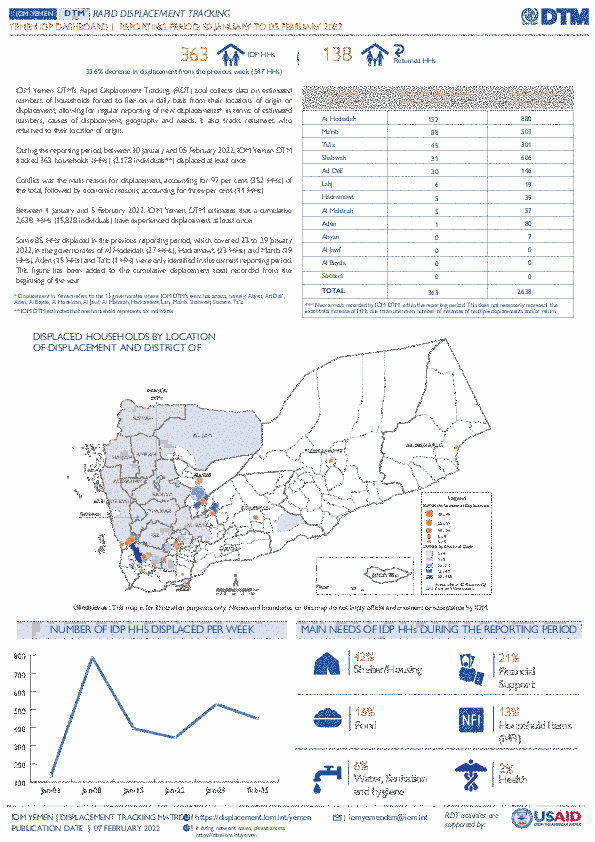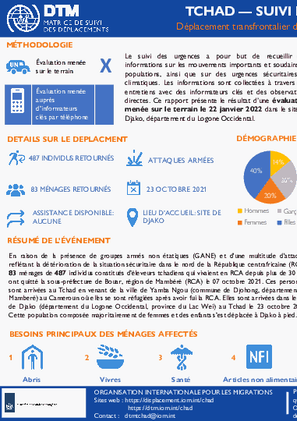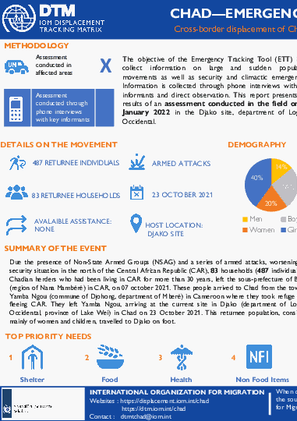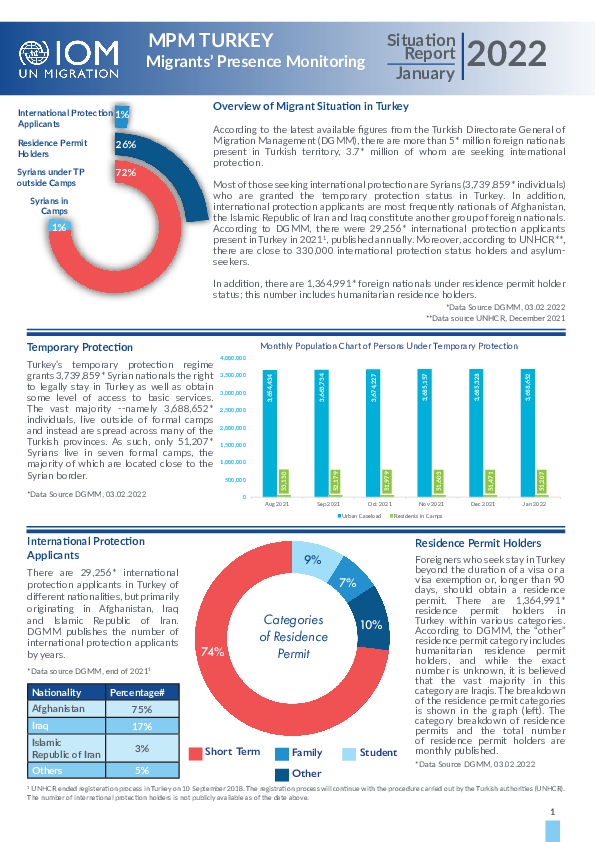-
Countries
-
Data and Analysis
-
Special Focus
-
Crisis Responses
Feb 09 2022
Print
Countries in this response
- Active DTM operation
- Past DTM operation

Contact
DTM Burundi, DTMBurundi@iom.int
Language
French
Location
Burundi
Period Covered
Jan 23 2022
Jan 29 2022
Activity
- Event Tracking
- Mobility Tracking
Entre le 23 et le 29 janvier 2022, la DTM a identifié 201 personnes affectées inclues 201 personnes déplacées par des pluies torrentielles dans la provinces de Rutana.

Contact
DTM Yemen, iomyemendtm@iom.int
Language
English
Location
Yemen
Period Covered
Jan 30 2022
Feb 05 2022
Activity
- Rapid Emergency Registration
- Mobility Tracking
IOM Yemen DTM’s Rapid Displacement Tracking (RDT) tool collects data on estimated numbers of households forced to flee on a daily basis from their locations of origin or displacement, allowing for regular reporting of new displacements in terms of estimated numbers, geography, and needs. It also tracks Returnees who returned to their location of origin.
From 01 January 2022 to 5 February 2022, IOM Yemen DTM estimates that 2,638 households (HH) (15,828 Individuals) have experienced displacement at least once.
Since the beginning of 2022, DTM also identified 10 displaced households who left their locations of displacement and either moved back to their place of origin or another location.
Between 30 January and 05 February 2022, IOM Yemen DTM tracked 363 households (2,178 individuals) displaced at least once. The top three governorates and districts where people moved into/within are:
- Al Hodeidah (152 HH) – Hays (137 HH), Al Khukhah (15 HH) districts. Most displacements in the governorate originated from Al Hodeidah and Taiz.
- Marib (88 HH) – Marib City (62 HH), Harib (16 HH), Marib (10 HH) districts. Most displacements in the governorate originated from Marib and Dhamar.
- Taiz (45 HH) – Salah (16 HH), Jabal Habashi (14 HH), Al Mawasit (7 HH) districts. Most displacements in the governorate originated from Taiz and Al Hodeidah.
Most displacements resulted from the increased conflict in the following governorates and districts.
- Al Hodeidah (122 HH) – Hays (109 HH), Jabal Ras (10 HH), Zabid (3 HH) districts.
- Taiz (86 HH) – Maqbanah (54 HH), Jabal Habashi (15 HH), Dimnat Khadir (5 HH) districts.
- Marib (55 HH) – Harib (32 HH), Al Jubah (16 HH), Marib City (6 HH) districts.

Contact
DTM Tchad, dtmtchad@iom.int
Language
English
Location
Chad
Snapshot Date
Oct 23 2021
Activity
- Event Tracking
- Mobility Tracking
Le suivi des urgences a pour but de recueillir des informations sur les mouvements importants et soudains de populations, ainsi que sur des urgences sécuritaires et climatiques. Les informations sont collectées à travers des entretiens avec des informateurs clés et des observations directes. Ce rapport présente le résultat d’une évaluation menée sur le terrain le 22 janvier 2022 dans le site de Djako, département du Logone Occidental.
En raison de la présence de groupes armés non étatiques (GANE) et d'une multitude d'attaques reflétant la détérioration de la situation sécuritaire dans le nord de la République centrafricaine (RCA), 83 ménages de 487 individus constitués d’éleveurs tchadiens qui vivaient en RCA depuis plus de 30 ans, ont quitté la sous-préfecture de Bouar, région de Mambéré (RCA) le 07 octobre 2021. Ces personnes sont arrivées au Tchad en venant de la ville de Yamba Ngou (commune de Djohong, département de Mamberé) au Cameroun où elles se sont réfugiées après avoir fui la RCA. Elles sont arrivées dans le site de Djako (département du Logone Occidental, province du Lac Wei) au Tchad le 23 octobre 2021. Cette population composée majoritairement de femmes et des enfants s’est déplacée à Djako à pied.

Contact
DTM Chad, dtmtchad@iom.int
Language
English
Location
Chad
Snapshot Date
Oct 23 2021
Activity
- Event Tracking
- Mobility Tracking
The objective of the Emergency Tracking Tool (ETT) is to collect information on large and sudden population movements as well as security and climactic emergencies. Information is collected through phone interviews with key informants and direct observation. This report presents the results of an assessment conducted in the field on 22 January 2022 in the Djako site, department of Logone Occidental.
Due the presence of Non-State Armed Groups (NSAG) and a series of armed attacks, worsening the security situation in the north of the Central African Republic (CAR), 83 households (487 individuals) of Chadian herders who had been living in CAR for more than 30 years, left the sous-prefecture of Bouar (region of Nana Mambéré) in CAR, on 07 october 2021. These people arrived to Chad from the town of Yamba Ngou (commune of Djohong, department of Mberé) in Cameroon where they took refuge after fleeing CAR. They left Yamba Ngou, arriving at the current site in Djako (department of Logone Occidental, province of Lake Wei) in Chad on 23 October 2021. This returnee population, consisting mainly of women and children, travelled to Djako on foot.

Contact
DTM Turkey, dtmturkey@iom.int
Language
English
Location
Republic of Türkiye
Period Covered
Jan 01 2022
Jan 31 2022
Activity
- Flow Monitoring Survey
- Flow Monitoring
- Migrants presence
The report presents monthly figures on migrants presence in Turkey, on apprehended/rescued persons on sea, on intercepted persons on land, and on resettlement of Syrians from Turkey.

Contact
DTM Turkey, dtmturkey@iom.int
Language
English
Location
Republic of Türkiye
Period Covered
Jan 01 2022
Jan 31 2022
Activity
- Flow Monitoring Survey
- Flow Monitoring
- Migrants presence
According to the latest available figures from the Turkish Directorate General of Migration Management (DGMM), there are more than 5* million foreign nationals present in Turkish territory, 3.7* million of whom are seeking international protection.
Most of those seeking international protection are Syrians (3,739,859* individuals) who are granted the temporary protection status in Turkey. In addition, international protection applicants are most frequently nationals of Afghanistan, the Islamic Republic of Iran and Iraq constitute another group of foreign nationals.
According to DGMM, there were 29,256* international protection applicants present in Turkey in 20211, published annually. Moreover, according to UNHCR**, there are close to 330,000 international protection status holders and asylum seekers. In addition, there are 1,364,991* foreign nationals under residence permit holder status; this number includes humanitarian residence holders.
*Data Source DGMM, 03.02.2022
**Data source UNHCR, December 2021

Contact
DTM Mauritania, DTMMauritania@iom.int
Language
French
Location
Mauritania
Period Covered
Dec 01 2021
Dec 31 2021
Activity
- Event Tracking
- Flow Monitoring
La transhumance est une pratique de longue date en Mauritanie où elle a évolué au cours des dernières décennies telles que la raréfaction des ressources impliquant la redéfinition des routes empruntées par les troupeaux. Par conséquent, des conflits peuvent survenir lorsque les agriculteurs et les éleveurs transhumants. Dans le cadre du Suivi des Mouvements de Transhumance, l’OIM met en œuvre un système d’alerte qui a pour objectif de recenser les mouvements inattendus de bétail et les conflits ou catastrophes naturelles liés à l’utilisation des ressources naturelles et aux interactions entre agriculteurs et éleveurs, de comprendre les modes de résolution de conflits existants et d’informer les autorités compétentes, dans l’objectif de réduire les tensions dans les régions d’intervention. Ce tableau de bord présente les informations fournies par le biais de 21 informateurs clés, présents dans huit régions (Assaba, Brakna, Gorgol, Guidimakha, Hodh El Chargui, Hodh El Gharbi, Tagant et Trarza) pendant le mois de décembre 2021.
Contact
DTM Yemen, iomyemendtm@iom.int
Location
Yemen
Activity
- Event Tracking
- Mobility Tracking
Period Covered
Jan 30 2022 -Feb 05 2022
From 01 January 2022 to 5 February 2022, IOM Yemen DTM estimates that 2,638 households (HH) (15,828 Individuals) have experienced displacement at least once.
Since the beginning of 2022, DTM also identified 10 displaced households who left their locations of displacement and either moved back to their place of origin or another location.
Between 30 January and 05 February 2022, IOM Yemen DTM tracked 363 households (2,178 individuals) displaced at least once. The top three governorates and districts where people moved into/within are:
• Al Hodeidah (152 HH) – Hays (137 HH), Al Khukhah (15 HH) districts. Most displacements in the governorate originated from Al Hodeidah and Taiz.
• Marib (88 HH) – Marib City (62 HH), Harib (16 HH), Marib (10 HH) districts. Most displacements in the governorate originated from Marib and Dhamar.
• Taiz (45 HH) – Salah (16 HH), Jabal Habashi (14 HH), Al Mawasit (7 HH) districts. Most displacements in the governorate originated from Taiz and Al Hodeidah.
Most displacements resulted from the increased conflict in the following governorates and districts.
• Al Hodeidah (122 HH) – Hays (109 HH), Jabal Ras (10 HH), Zabid (3 HH) districts.
• Taiz (86 HH) – Maqbanah (54 HH), Jabal Habashi (15 HH), Dimnat Khadir (5 HH) districts.
• Marib (55 HH) – Harib (32 HH), Al Jubah (16 HH), Marib City (6 HH) districts.
Population Groups
Survey Methodology
Unit of Analysis Or Observation
Type of Survey or Assessment
Keywords
Geographical Scope
Administrative boundaries with available data
The current dataset covers the following administrative boundaries
Contact
DTM Malawi, DTMMalawi@iom.int
Location
Malawi
Activity
- Mobility Tracking
- Baseline Assessment
Period Covered
Jan 28 2022 -Jan 31 2022
A baseline assessment is a sub-component of mobility tracking. It aims to collect data on IDP, migrant or returnee population presence in a defined administrative area of the country.
This dataset contains displaced household figures at site level.
Population Groups
Survey Methodology
Unit of Analysis Or Observation
Type of Survey or Assessment
Keywords
Geographical Scope
Administrative boundaries with available data
The current dataset covers the following administrative boundaries